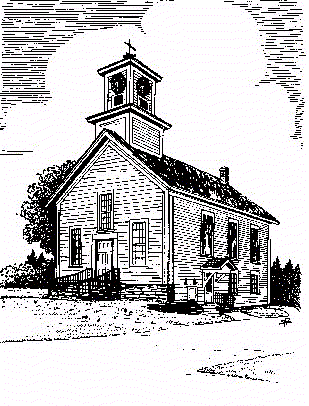A notice which was to rule the future of the Binghamville Church read as follows: "Notice is hereby given to those having subscribed funds for the erection of a church to be located in Binghamville or district No. 8 of Fletcher to meet at the brick school house in said district on Saturday the 4th day of December A.D. 1869 at 6 P.M. to elect a building committee and select site for said house and to make all other necessary arrangements for the erection of said house." R. H. Bingham, Sec. The meeting was held and a constitution and bylaws were drafted and committees elected. In one week another meeting was held when each article of the constitution was voted upon separately and accepted.
Forty two persons signed the constitution and it was voted to have the building committee "erect said church until the funds already subscribed or may be subscribed are expended." The building committee was directed to buy one half acre of land of George M. Scott "on the corner in such shape as they saw fit". The vote was rescinded "to set the house down by the burying ground".
By September 1, 1870 the building committee was instructed to finish the church at as low a rate as advisable except the basement and to take the house for security for the extra expense of stoves and pipe to be included.
At a meeting January 7th, 1871 it was voted to have the building committee appraise the pews to be sold. It was also voted to paint the basement.
In the records a copy of the receipts for each of the persons who bought pews was recorded. The Meeting House Company received from thirty-five to one hundred dollars for each pew. Some bought more than one and at least two people bought one half a pew each.
The story is told that it took several pairs of oxen to haul the large stones which made the front steps of the church. No doubt the stones for the foundation were drawn by oxen.
For several years, each year at the annual meeting of the Baptist and Methodist Meeting House Company it was decided who would furnish wood and lights for the church and also who would serve as janitor. At the meeting in January of 1872 there was still need of donations to finish the painting.
At a later date it was voted to put a tax on pews, a sufficient sum to pay the janitor. Trustees were elected at each annual meeting, also a moderator, a clerk, a collector and a treasurer.
The sheds which provided a place for horses and wagons or sleighs were built soon after the church was completed. They were sold to the people the same as the pews in the church, twenty-five dollars seemed to be the going price. As time went on they were transfered from one person or estate to another person.
The records show that the first Baptist Society in Fletcher had their annual meetings at the Fletcher Town House. As soon as the Binghamville Church was built they joined with the Methodists but did have meetings by themselves for a few years, at the church.
More land was added to the church property by a deed signed by Phebe A. Bailey, October 31, 1890. The trustees were to pay $18.00 annually during the full term of the natural life of Mrs. Bailey until $300.00 had been paid, but upon the death of Mrs. Bailey the payments would cease. The $18.00 was to be paid for the following purposes: $12.00 to be paid to the Methodist Society for preaching, $5.00 to the Baptist Society for preaching, and $1.00 for taking care of the church.
The records show that in 1917, $560.00 was borrowed to help defray the expenses of the church and was to be repaid at $50.00 a year plus the interest. In 1931 the amount had been paid and there was no record of having to borrow money again.
The church was not incorporated as the "Binghamville Methodist Church" until July 8, 1963.
In the early 1920's it became a hardship to pay a minister's salary and keep the parsonage and church in repair. The parsonage was sold and the church was served by the pastor from the Methodist Church of Fairfax, which later became the United Church.
Home Page /
About Us /
Location /
Join Us /
Calendar /
Links /
Contact Information /
Building History /
Memorial Clock
 Reprinted from History of Binghamville, Anniversary Booklet, Centennial Celebration and Rededication
Reprinted from History of Binghamville, Anniversary Booklet, Centennial Celebration and Rededication
The preamble to the constitution for the Fletcher Baptist and Methodist Meeting House Company read as follows: "As the great Jehovah requires of his intelligent creatures the assembling of themselves together to worship Him and as such requirements cannot be answered without a suitable place to worship Him in, we therefore in order to comply with so reasonable a command do enter into a compact for the purpose of building and keeping in repair a house for public worship."
 2001-
Binghamville United Methodist Church
2001-
Binghamville United Methodist Church